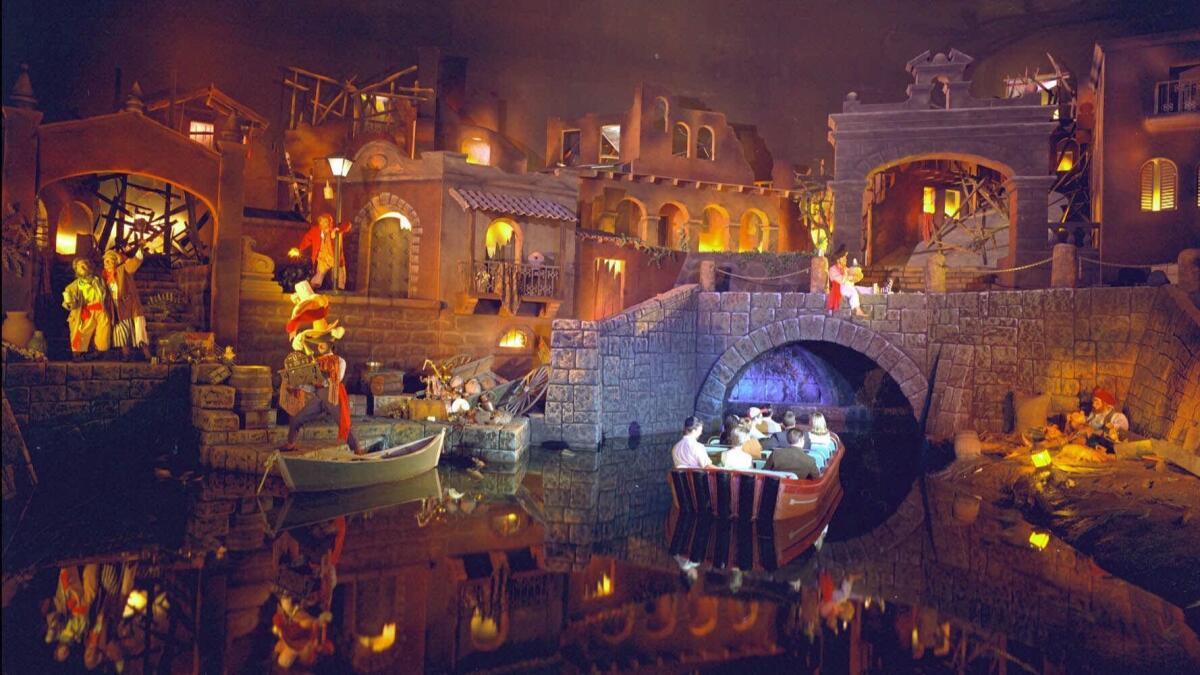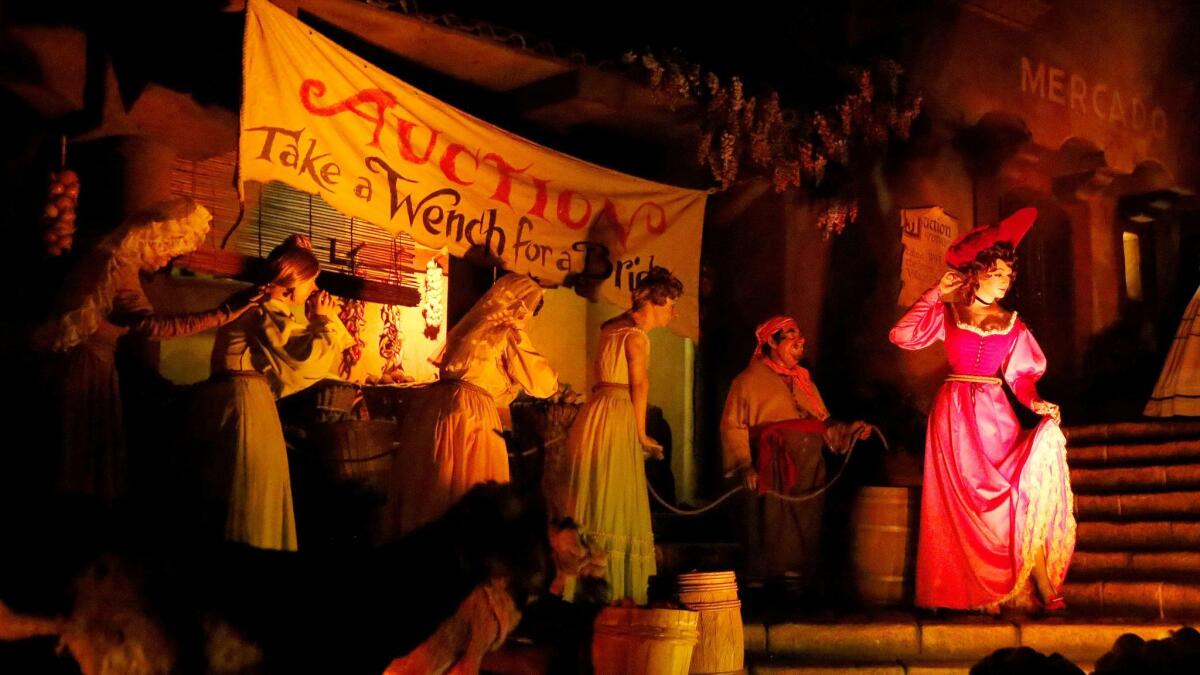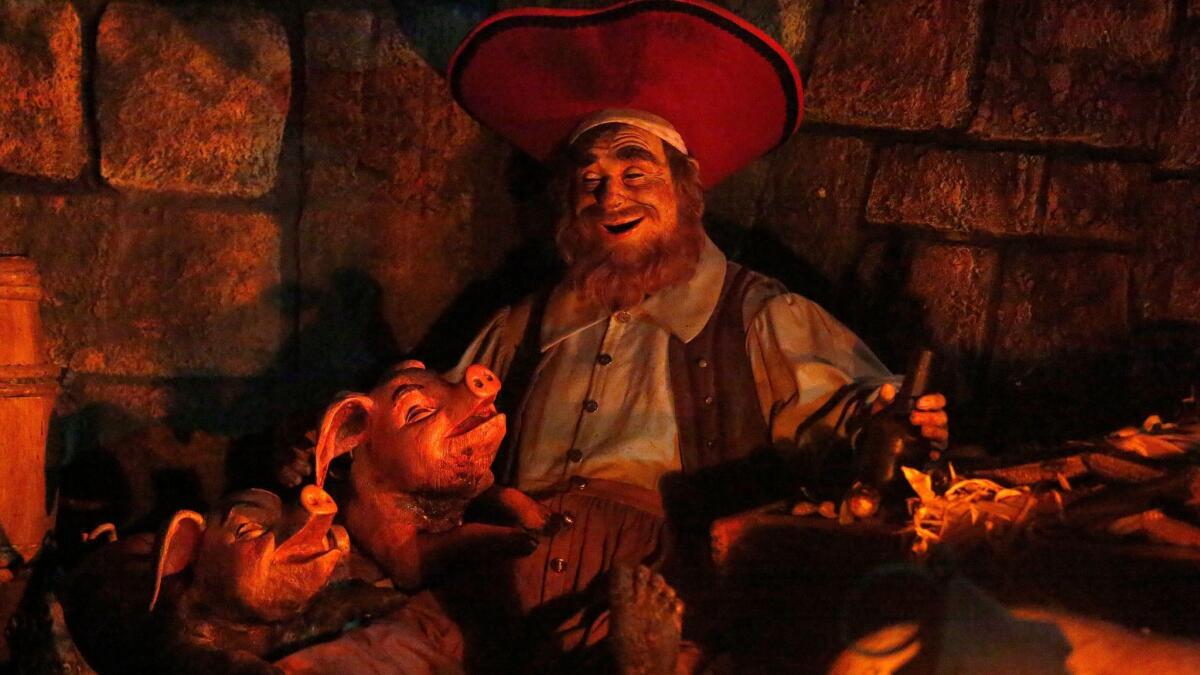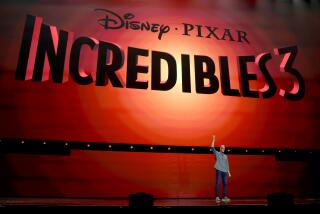Pirates of the Caribbean anchors a Disneyland on the brink of great change

Fifty years ago, Disneyland opened Pirates of the Caribbean, an attraction that one of the company’s former top creative executives still describes as “the greatest ride in Disneyland history.”
On the 15-minute water-led excursion, guests first wind through skull- and treasure-laden caverns before going back in time to an era when those pirate skeletons were joyful looters.
For the record:
4:00 p.m. July 10, 2017An earlier version of this post misspelled the last name of former Imagineer Claude Coats as Coates. Additionally, the last name of current Imagineer Kathy Mangum appeared on some references as Magnum.
A morality tale in reverse, then — the celebrated “pirate’s life” ends inevitably in death and desiccation. Or maybe not — after all these years, the ride remains open to interpretation even among the most dedicated of Disney philes.
“I’ve tried to analyze what is happening in that ride,” says Tony Baxter, a former senior executive at Walt Disney Imagineering and now a creative consultant for the division. “Is it a book report of some movie? I think it’s more metaphorical to falling asleep and having this incredible dream-like experience.”
From the time it opened, Pirates has been one of the park’s best-known and most popular attractions; it is also one of its most elastic. Though never transformed for any holiday, the ride has survived numerous tweaks through the decades. At Disneyland, scenes have been altered over the years to heighten association to Capt. Jack Sparrow of the “Pirates of the Caribbean” movies and to downplay the aggressive lust of the seafaring rogues; an upcoming change involving the bridal auction was recently announced.
At other Disney parks, the ride has been adjusted in even more essential ways: At Disneyland Paris, Pirates unfolds in a more chronological fashion; at Shanghai Disneyland, it is much more closely aligned with the films.
Even so, the Pirates of the Caribbean tale continues to remain somewhat elusive, perhaps symbolic of the cryptic nature of Imagineering, Disney’s highly secretive arm devoted to theme park experiences.
Beginning July 14, however, some of those secrets will be laid bare. At the D23 Expo, Disney’s biennial three-day fan fest, Pirates will dominate the Anaheim Convention Center with a museum-like exhibit and a Friday afternoon talk by Imagineers such as Baxter and Orlando Ferrante, the latter of whom worked on the Disneyland original, that will take the audience through the 50-year history of the attraction.
Period of growth
It’s a swashbuckling celebration that will also offer a spoon full of sugar; Disney, like its Caribbean ride, is adapting to today’s cultural climate. The parks are currently in the midst of a period of growth. “Star Wars”-inspired lands are coming to Disneyland and Walt Disney World in Orlando, Fla., with the latter also receiving a “Toy Story”-themed area. Around the globe, Disney parks are increasing their Marvel presence, and Hong Kong Disneyland is destined to receive an injection of “Frozen.”
RELATED: Disneyland’s Pirates of the Caribbean: 50 years of change
Such widespread change has provoked as much anxiety as excitement — can Disney parks maintain the Disney magic with all those Avengers on the loose? As a classic that has been forced to keep up with the times and deal with big-screen fame, Pirates offers hope that the parks can be modern while still feeding the magic of nostalgia. Because, Imagineering luminaries say, one central tenet continues to connect all the disparate properties: storytelling.
“If you go back, the amusement business didn’t tell stories,” former Imagineering chief Marty Sklar says of theme parks before Disneyland.
“They were just thrill rides. Walt [Disney] changed that by creating stories. That’s the basis of everything that Imagineering does. When I talk to Imagineers, I always say I’m jealous because they have so many new technologies, but you have to have a good story or else you’re wasting your time.”
Walt [Disney] changed that by creating stories. That’s the basis of everything that Imagineering does.
— Marty Sklar, former Imagineering chief
A peek at the future
While Disney doesn’t release attendance forecasts, more than 65,000 die-hards typically come to D23 looking for an early look at the company’s future and insights into its past. This year’s biggest draw will no doubt be the pavilion dedicated to Disney parks, which will reveal for the first time the model of the in-development “Star Wars”-inspired lands.
Talks throughout the weekend will also probe the depths of Imagineering. One will focus on Disney’s legacy of female Imagineers, while another will look at the Imagineers who have been deemed “Disney Legends,” including Baxter, Sklar and this year’s honoree, Wayne Jackson.
There also will be a spotlight on Pirates of the Caribbean, which even in its middle age is serving as a microcosm for Disney’s need to adapt to generational shifts. Those who are resistant to change will no doubt have strong opinions about the recent announcement that the bridal auction scene in Pirates will be modified at Disneyland, Walt Disney World and Disneyland Paris; by the end of next year, looted trinkets, not women, will be on the block.
Those fans who object can console themselves with the knowledge that the red-headed woman, who currently seems to approach her precarious position with a bit of a femme fatale attitude, will be staying.
Originally conceived by animator-turned-Imagineer Marc Davis, the Redhead, as she’s known, has become a fan favorite.
“If you look at her in that scene, she’s the center of attention,” says Kathy Mangum, a senior vice president with Imagineering. “She’s certainly the anti-victim. If you look at the other women next to her who are tied up, they’re very much the victim, but you can tell she’s used to being the center of attention and she seems to be enjoying it.”

Soon, the Redhead will take on a role of even greater importance, transitioning from a prisoner to fearsome pirate, part of the crew forcing town residents to surrender their wares.
While the scene preserves the auction, which was part of the ride’s March 1967 opening, it also gives Pirates of the Caribbean something the attraction has long lacked — a strong central female character — while doing away with a set piece that relegates women to property.
Mangum says that Imagineering has been pondering changes to the scene for a while, but was slow to act in part because Pirates is the last ride overseen by Walt Disney himself.
After consulting with diversity groups, including Imagineering’s in-house WIN — the Women’s Inclusion Network — Imagineering decided to adapt the ride for a generation weaned on strong female Disney characters such as Merida, Elsa, Moana and Judy Hopps.
“Last November, for the first time, we had a woman who was a viable candidate for the president of this country,” Mangum says. “I hate to say times are changing, but there’s an advancement in pop culture and society, and the timing felt right. We didn’t link it to any one initiative, but as we talked about it, we couldn’t think of a really valid reason for keeping it as it is.”
‘Tie-back to Walt’
Does she expect a backlash? “Because it was Walt’s last attraction,” Mangum says, some fans are “not going to want any kind of change. We understand that. I understand that. But it’s the same reason we added Jack Sparrow. You have to think ahead to other generations who won’t have the tie-back to Walt.”
And yet even Walt had some doubts about the scene. In an interview in a 1999 issue of the E-Ticket, a now-defunct Disney parks fanzine, Claude Coats, an Imagineer instrumental in the creation of Pirates of the Caribbean, recalled Walt’s reaction upon seeing a near-completed version of the auction scene.
“He came in one time and even said, ‘This will be all right, won’t it?’ He was just a little doubtful of auctioning off the girls. Was that quite ‘Disney’ or not?”

A focus on farce
Yet the ride, originally planned as a walk-through with wax figures, has endured, says Sklar, not because it emphasizes the harrowing acts but because it focuses on farce. “I think it was approached from the standpoint of the humor,” Sklar says.
Disney’s love affair with pirates extends far beyond the ride and film franchise. Walt Disney’s first known foray into pirating was the 1927 short “Alice Foils the Pirates,” the 42nd of his 56 Alice Comedies, films that featured animated backgrounds with a live action young girl.
While “Alice Foils the Pirates” is considered a lost film, D23’s pirate exhibit will feature art from some never-made pirate-themed cartoons, including one that would have starred Donald Duck, as well as artifacts from the ride and the “Pirates of the Caribbean” films.
And looking at Disneyland’s Pirates of the Caribbean, as well as its surrounding New Orleans Square, may even give some hints about Disney’s future. Today, be it the “Avatar”-inspired Pandora at Walt Disney World or Cars Land in Anaheim, or the “Star Wars” lands in development, theme parks are moving toward bigger, more fully immersive worlds based on a single theme.
New Orleans Square is often considered the template for such an approach, so much so that some fans have constructed a narrative that ties Pirates of the Caribbean with the Haunted Mansion. One doesn’t exist, however, says a spokesman for Imagineering.
“Before you get to Pirates,” Baxter says, “you’ve been immersed in a world that is complete. Even the Mark Twain sailing by New Orleans is part of that story.”
To those nervous about a park overrun by Stormtroopers and superheroes, Baxter offers the reassurance that Pirates will remain a cornerstone. “It has so many yardsticks by which everything is measured that I think it will stay in position as our primary wonder for a long time.”
Follow me on Twitter: @toddmartens
ALSO
Meet Disney’s philosopher king: the brain behind ‘Avatar’s’ Pandora and Marvel’s ‘Guardians’ ride
Behold animatronic Cosmo (and Rocket) inside Disneyland’s ‘Guardians of the Galaxy’ ride
More to Read
The biggest entertainment stories
Get our big stories about Hollywood, film, television, music, arts, culture and more right in your inbox as soon as they publish.
You may occasionally receive promotional content from the Los Angeles Times.











